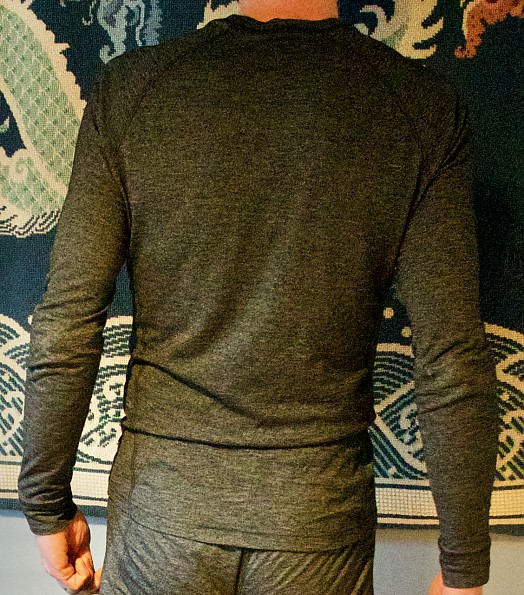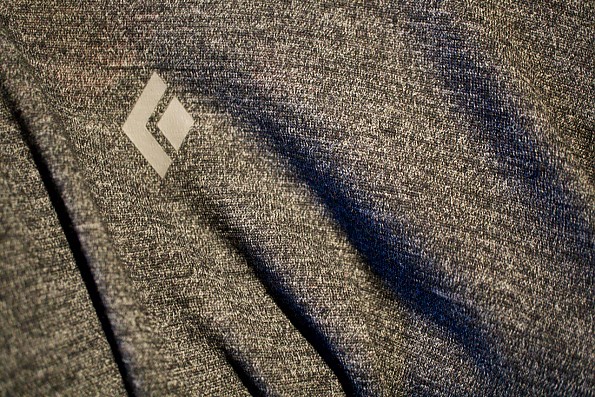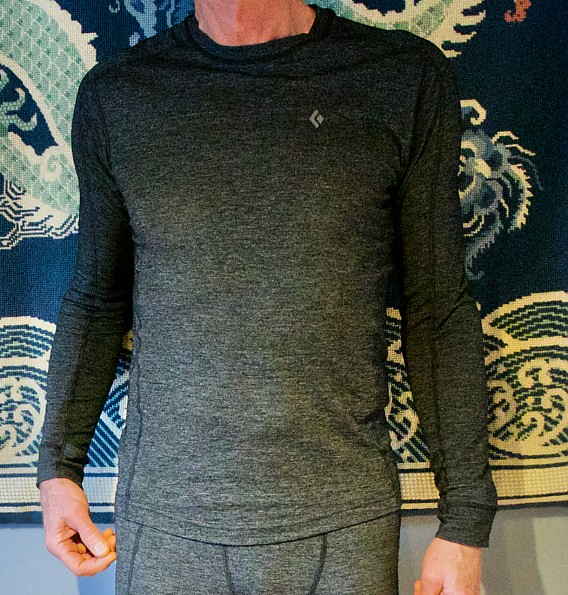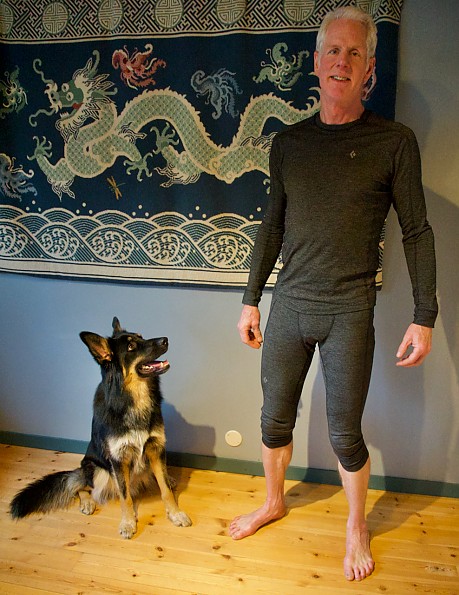Black Diamond Men's Solution 150 Merino Base Crew

Black Diamond's Solution 150 Merino Base Crew is a lightweight, polyester-reinforced merino wool base layer. Cool enough to wear under light shell clothing for high intensity activity at around-freezing temperatures without overheating, but easily layered over for use in colder conditions or at lower intensity. Stretch fabric gives a comfortable fit even on a slim frame and dries a little faster than 100 percent merino.
Pros
- Comfy fit and feel
- Light base layer for intensive activity
- Also good for cold-wet days in summer
- Lightweight in the pack
Cons
- Polyester core may shed microplastic fibers in wash water
- No long sizes
(Preliminary review based on the first month of use)
Black Diamond’s Solution 150 Base shirts and long underwear are lightweight, polyester-reinforced merino wool base layers. They are light enough to wear under light shell clothing for high intensity activity at around-freezing temperatures without overheating, but easily layered over for use in colder conditions or at lower intensity.
BD has supplied me with both a crew neck top and ¾ length bottoms for testing. Much of what I have to say about the one will apply to the other and so may be duplicated in both reviews. The Solution 150 lineup also includes a full length bottom, all three variants are also available in women's versions. There is also a nice-looking heavier weight Solution Merino Hoody (men's only), but so far no other top variants (zip-turtleneck, 1/4 zip, Wallace Beery).
Usage (so far)
I have been using the Solution top and bottoms as my base layer on about 30 days worth of outings so far, mainly for 1-4 hour xc ski tours at a high energy level, but also some winter trail running and hut-based backcountry skiing, including some lounging around wood-heated Norwegian huts.
Rather than pure merino wool, BD’s NuYarn has a 22 percent stretch polyester core wrapped in fine merino wool to give a stretchy, thin knit fabric that weighs in at a light 150 grams per square meter. BD claims it is stronger and warmer and will dry faster than other merino wool fabrics while maintaining merino's odor resistance.
My trial shirt has a classy gray flannel look; light blue is currently the only other color choice. The knit fabric feels a bit thinner and lighter than some of my other merino layers, a welcome difference for me because I easily overheat. The fine merino wool feels good on the skin, with none of the itchiness that comes with some wool garments. Strategically placed flat seams minimize rubs and pressure points from pack straps. The close stretch fit and thumb holes makes it easy to layer over with stretch fleece or other close-fitting layers.
Like pure merino, NuYarn has proved to be smell-resistant. I prefer to hand wash my woolies, and that infrequently, to extend their life, although BD allows gentle machine washing. So far, I have washed the Solution duo only once. Intensive activity inevitably involves some sweating, and, like my pure merino tops, these layers have absorbed a lot of sweat without any noticeable BO buildup or that wash-resistant smell that plagues polyester base wear.
The tough polyester core may help give a longer life. Despite all its warm, smell-free wonders, 100 percent merino can wear thin and develop small holes after a few seasons of use. Only time and use can tell whether the NuYarn blend will hold up any better.
My size M weighs in at 172 g, about 100 g lighter than my newer Smartwool top, but the latter is a bit warmer so it’s a tradeoff.
Drying time
BD claims or at least suggests that the NuYarn fabric dries faster than pure merino: “We have engineered this fabric to be stronger, warmer, and dry faster than other Merino wool fabrics on the market by utilizing the technology of wrapping a nylon core with extra-fine Merino fiber.”
So I decided to do a drying test when I washed the crew top, by washing two 100 percent Merino tops, an old lightweight Patagonia Capilene top, and a synthetic hoodie at the same time. I hand-squeezed as much water as I could get out of each shirt without twisting, weighed them, hung them up to dry in a warm house on wire hangers, then weighed them periodically until they were dry or mostly dry. The result:
Eyeballing the slopes of the curves, the BD, Capilene, and red (well-worn) Smartwool seem to dry at a about the same rate, while a nearly new Smartwool and the NRS hoodie seem to dry relatively slowly or quickly, respectively.
If I recalculate the data using the post-squeeze weight as 100% relative water content and the dry weight as 0%, I get this:
After nine hours, the new Smartwool still had over 15 percent of its initial water remaining, while the BD Solution was down to about 7 percent and the other three shirts were completely dry (Capilene) or nearly so. The twist in this analysis is that the BD started out at a higher water content (data not shown; weight of water per weight of fabric) than any of the other shirts. This could be because it has greater water retention than the others, or because I inadvertently didn’t squeeze it as hard as the others. Next time I wash I will squeeze good and hard and see if I get the same wet weight.
Taken at face value, this analysis indicates that a new BD solution shirt dries faster than a new 100 percent Merino wool top, but somewhat slower than the two synthetic shirts and a well-worn Merino shirt that has lost a lot of its outer fuzz. Anecdotally, I can say that a sweat-soaked Solution 150 shirt will dry by body heat in an hour or so during a ski descent or other period of reduced activity.
Being tall and thin, getting outdoor clothes that fit is always a concern for me. In shirts I usually buy size large to make sure they are long enough to reach my wrist and waist. However, the sleeve length is the same in BD’s M and L sizes, 86.5 cm (34 in), nominally too short for me but I decided to give the M a try. Good choice—the shirt is a snug fit all around, not too tight in the chest or under the arms, just long enough to stay tucked in, and a bit too short in the sleeves so that they feel a bit stretched if I use the thumb holes. I would prefer a medium long size for an even better fit, but the stretch knit fabric should accommodate a wide variety of body types that are closer to average proportions than I am.
I would describe the overall fit as snugly comfortable, enough so that I am happy to just lounge around in the BD base layers après ski.
Temperature Range
The temperatures during use so far ranged from about -8 to +5˚C (18 to 40˚F). At the above-freezing end of that range I worked up a pretty good upper body sweat while xc skiing, wearing the crew top under a light single layer shell, but that is pretty much unavoidable. At -2˚C (28˚F) in the same layers I might start out cold but feel just right after warming up. Below -5˚C (21˚F) I want another layer, often a light fleece vest.
Worn under waterproof-breathable bibs with knee socks and with suitable upper body layers, the Solution 150 top and bottom are ideal for backcountry skiing temperatures down to -10 or maybe a bit lower. Based on experience with other wool base layers, I think the Solution base layers worn under rain gear or shorts would also work well for hiking in cold mountain rain in summer or as evening wear around camp. The lightweight fabric is a plus for gram-shavers.
Conclusion (so far)
I am very happy with the fit, comfort, and performance of the BD Solution 150 lineup as a base layer for moderate to high activity such as backcountry and xc skiing in cold weather. I will continue using it for the rest of the ski season and report back in the spring.
Background
About a month's use so far, including about three weeks of daily/nightly xc ski tours while we had good snow, three hut trips, and some icy trail runs. These are the latest in a lifetime of long underwear, dating back to the cotton wafflewear I wore as a kid.
Source: received for testing via the Trailspace Review Corps
(Sample for testing and review provided by Black Diamond)
Your Review
Where to Buy
You May Like
Specs
| Price |
MSRP: $119.00 Current Retail: $67.50-$135.00 Historic Range: $67.50-$135.00 |
| Weight |
190 g |
| Materials |
Merino Wool Blend Single Jersey (150gsm, 78% Merino Wool, 22% Polyester) |







